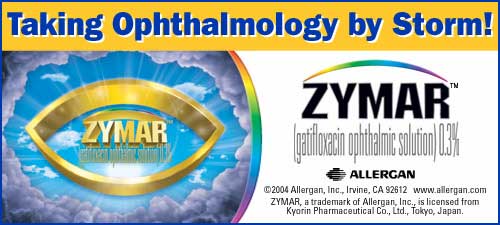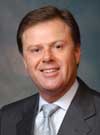
| |
Volume 4, Number 47
|
Monday, November 22, 2004
|

|
||
| Levels of Free
UV Filters and Amino Acids in Cataract vs. Normal Lenses Investigators at the Australian Cataract Research Foundation, University of Wollongong, New South Wales, Australia, conducted a study aimed at determining the levels of free ultraviolet (UV) filters and selected amino acids in cataract lenses compared with the levels in normal lenses. Thirty-nine cataract lenses and six normal lenses were examined by high performance liquid chromatography to quantify levels of UV filter compounds, the UV filter precursor amino acid tryptophan (Trp) and tyrosine (Tyr) and uric acid. The levels of the two major primate UV filters, 3-hydroxykynurenine glucoside (3OHKG) and 4-(2-amino-3-hydroxyphenyl)-4-oxobutanoic acid glucoside (AHBG), in cataract lenses were markedly decreased compared with levels in normal lenses. By contrast, the levels of Trp were greatly increased in cataract lenses. Mean Trp concentrations were an order of magnitude higher than in normal lenses, with 86 percent of dark-colored cataract lens nuclei having Trp concentrations greater than the mean level in the normal lenses. The concentrations of Tyr were also higher in cataract lenses, but the levels of kynurenine were unchanged, and the uric acid levels were substantially lower. These results suggest that the metabolism of a large proportion of patients with cataract may be substantially different than in persons with normal lenses. Although the mechanism of such metabolic defects is unknown, the authors of this study believe that an amino acid transporter system may be upregulated in patients with cataract. Because kynurenine levels in cataract were not significantly different from those of normal lenses, they believe that there may be a defect in the lenticular UV filter pathway at one or both of the steps that convert kynurenine to 3OHKG. |
|
SOURCE: Streete IM, Jamie JF, Truscott RJ. Lenticular levels of amino acids and free UV filters differ significantly between normals and cataract patients. Invest Ophthalmol Vis Sci 2004;45(11):4091-8. |
|
| Outcome of CNV
in Angioid Streaks After Photodynamic Therapy Researchers at Italy’s University of Florence evaluated the visual and anatomic outcomes of photodynamic therapy for choroidal neovascularization (CNV) in patients with angioid streaks. The authors retrospectively evaluated 40 consecutive patients (48 eyes) with visual acuity of 20/200 or greater who were treated at six referral centers for CNV associated with angioid streaks. Main outcome measures were visual acuity, greatest linear diameter of the lesion and, in patients with nonsubfoveal CNV, distance from the foveola. Of 34 eyes with subfoveal CNV, 21 were followed up for at least 12 months (range, five to 33 months). Median visual acuity was 20/50 at baseline and 20/120 at the final examination. The 12-month estimate of the percentage of eyes with vision loss of fewer than three lines was 68 percent (95 percent confidence interval [CI], 50 to 85 percent) by using survival analysis, whereas eyes with no increase in the greatest linear diameter were 45 percent (95 percent CI, 27 to 62 percent). Eleven eyes had extrafoveal CNV and three had juxtafoveal CNV. Of these 14, 12 were followed up for at least 10 months (range, four to 36 months). Visual acuity was 20/40 or greater in all eyes with extrafoveal lesions at baseline and in five of 12 eyes at the last examination, when three cases of CNV had become subfoveal. At baseline, visual acuity was low in two eyes with juxtafoveal CNV and nearly normal in the third. It remained substantially stable at the end of follow-up (range, 10 to 36 months), when two lesions were subfoveal. Most of the patients in the study had good baseline visual function and were thus at high risk for losing vision because of the poor prognosis of CNV in angioid streaks. Because most had no or limited vision loss after one year, the authors suggest that photodynamic therapy can be used to try to limit or delay visual damage caused by this aggressive disease. |
|
SOURCE: Menchini U, Virgili G, Introini U, et al. Outcome of choroidal neovascularization in angioid streaks after photodynamic therapy. Retina 2004;24(5):763-71. |
|

|
||
| Fundus Autofluorescence
vs. Photopic and Scotopic Fine-matrix Mapping in Retinitis Pigmentosa
and Normal Acuity Patients High-density rings of fundus autofluorescence (AF), which are present in some patients with retinitis pigmentosa (RP) with normal visual acuity, demarcate areas of preserved central photopic sensitivity. Scotopic sensitivity losses encroach on areas within the ring of high density and may reflect dysfunction before accumulation of lipofuscin, according to researchers at the Moorfields Eye Hospital and the Institute of Ophthalmology in London. The study compared psychophysically determined spatial variations in photopic and scotopic sensitivity across the macula in patients with RP and normal visual acuity who manifest an abnormal high-density ring of AF. Eleven patients with a clinical diagnosis of RP were examined, all of whom had rod-cone dystrophy (International Society for Clinical Electrophysiology of Vision standard ERGs), visual acuity of 20/30 or better and an abnormal parafoveal annulus of high-density AF. Researchers performed fine-matrix mapping (FMM) over macular areas of abnormal high-density AF under photopic and dark-adapted conditions. They performed pattern ERGs (PERGs) in nine of 11 patients by using different sizes of circular checkerboards. Rings of high-density AF varied between patients (approximately 3 degrees to 18 degrees in diameter). Photopic sensitivity was preserved over central macular areas, but there was a gradient of sensitivity loss over high-density segments of the ring and severe threshold elevation outside the arc of the ring. Scotopic sensitivity losses were more severe, and they encroached on areas within the ring. The radius of the high-density ring correlated with the lateral extent of preserved photopic sensitivity and PERG data. |
|
SOURCE: Robson AG, Egan CA, Luong VA, et al. Comparison of fundus autofluorescence with photopic and scotopic fine-matrix mapping in patients with retinitis pigmentosa and normal visual acuity. Invest Ophthalmol Vis Sci 2004;45(11):4119-25. |
|

|
||
| Juvenile Arthritis-associated
Uveitis: Visual Outcomes and Prognosis The current issues in the management of uveitis associated with juvenile arthritis revolve mainly around the treatment of mild disease and how to treat patients with more severe disease. The aims of this study were to determine the incidence of uveitis in a cohort of patients with juvenile arthritis as well as the nature of treatment and the risk factors for visual loss. The investigators reviewed the charts of 71 patients (47 girls and 24 boys) aged 16 months to 13 years, who had juvenile arthritis as defined by the American Academy of Rheumatology and who were seen between 1992 and 2001 at a combined rheumatology and ophthalmology clinic. The median age at diagnosis of juvenile arthritis was four years and one month. Twenty-seven patients (38 percent) had uveitis; the median age at uveitis onset was 5.9 years, with an average interval of 18 months from the diagnosis of arthritis; 11 patients had uveitis at the time of arthritis diagnosis. Information collected included rheumatologic diagnosis, results of serologic testing and details of systemic and topical treatments. Results showed a positive relation between antinuclear antibody positivity and the development of uveitis. Thirteen (48 percent) of the 27 patients with uveitis had mild anterior segment inflammation with fewer than 25 cells in the anterior chamber. This group had spontaneous resolution of uveitis without topical therapy. All the patients without uveitis had a final visual acuity of 6/9 (20/30) or better. Five of the patients with uveitis had a final visual acuity of 6/36 (between 20/100 and 20/125) or worse. Cataract was the most common complication affecting visual outcome. Cataract extraction initially improved the visual acuity, but posterior segment complications and glaucoma compromised the final visual outcome. |
|
SOURCE: Chen CS, Roberton D, Hammerton ME. Juvenile arthritis-associated uveitis: visual outcomes and prognosis. Can J Ophthalmol 2004;39(6):614. |
|
BRIEFLY
|
|
|
||||||||||||||
| Subscriptions: Review of Ophthalmology Online
is provided free of charge as a service of Jobson Publishing, LLC. If
you enjoy reading Review of Ophthalmology Online, please tell a
friend or colleague about it. Forward this newsletter or send this address:
[email protected].
To change your subscription, reply to this message and give us your old
address and your new address; type "Change of Address" in the
subject line. If you do not want to receive Review of Ophthalmology
Online, reply to this message and type "Unsubscribe: Review of Ophthalmology
Online" in the subject line. Advertising: For information on advertising in this e-mail newsletter or other creative advertising opportunities with Review of Ophthalmology, please contact publisher Rick Bay, or sales managers James Henne or Michele Barrett. News: To submit news, send an e-mail, or FAX your news to 610.492.1049 |
















